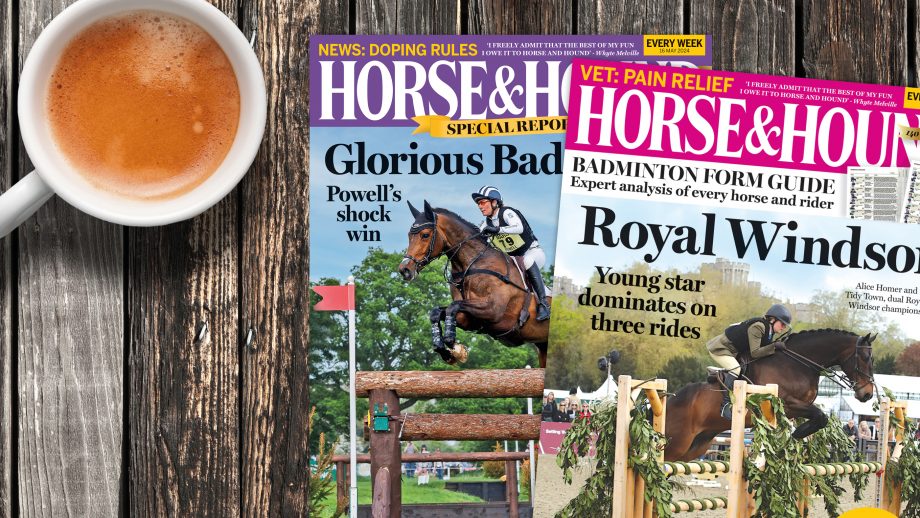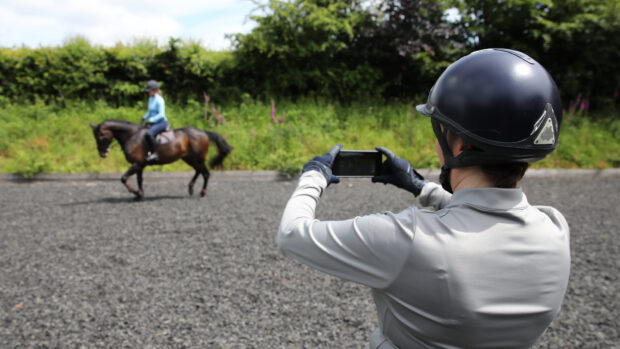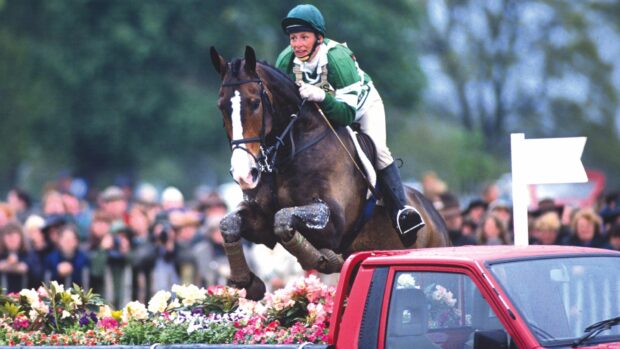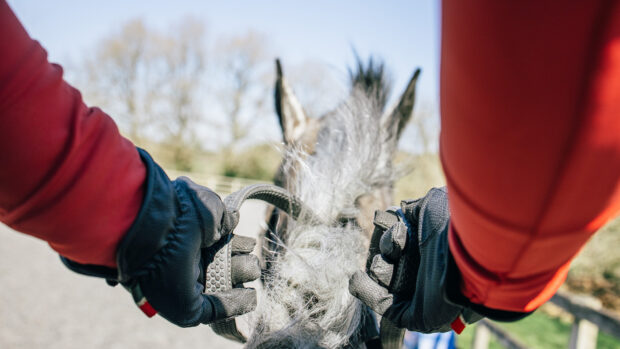If you tend to head into the school without a plan of what to do, spend half an hour trotting absent-mindedly in straight lines and circles and put your horse away without a great deal of satisfaction or sense of improvement, you’re not alone. Many of us don’t have much of a structure to our schooling sessions.
While large arenas, fancy jumps and poles are the dream, most riders make do with a 20x40m school – or a field – for our flatwork. However, such limitations shouldn’t hamper our progress. In these super-simple training exercises with Mary King, she shows us how all you need is room to ride a 20m circle and a bit of self-discipline.
Rather than following intricate patterns and complicated exercises, these work on doing the basics really well.
Training with Mary King
1. Rider position
Aim: to have a better seat and be more balanced for all disciplines.
When you ride a 20m circle, it’s a chance to evaluate your position and improve it. We naturally focus on our horse and its way of going, but we are a major part of the equation. Mary suggests riding on a circle in trot, analysing each part of your body to assess whether you are in the correct position. Then make a transition to walk, while maintaining the same good position.
Mary says: “Think of a rider whose position you really admire, and try to channel them as you ride around the circle.
“Carl Hester’s tip is to make the front of your body longer, rather than just sitting up tall.”
Head: Mary advises keeping your head straight, and looking directly ahead, not down towards the ground.
“Don’t look to the inside, look between the ears, forward and in front of you, not turning too much.
Hands: “Your hands should not be going up and down with your body as you rise to the trot,” says Mary. “You should be able to hold your hands so they are not resting on the withers, and they should stay still. Glance down at them as you are trotting along to see if you are keeping them still.”
Mary’s tip is to keep a “nice bend in the elbow to help soften your hands”.

Mary encourages riders to glance down to see if their hands are still – but not resting on the withers – with a bend in the elbow, before looking ahead again. Credit: Emma Herrod
Lower leg: Mary rides dressage with her stirrups 10 holes lower than for cross-country. Whatever length your stirrups, keep your ankles relaxed so your heels are softly down, and use your calf to give leg aids clearly rather than nagging with your heels.
“If your horse is lazy, don’t just keep pressing or your heels will rise,” she advises. “Give more of a slap with your lower leg, then keep the leg still.”
2. Transitions
Aim: to make your horse more responsive, enabling you to make transitions at exact markers.
Mary regularly uses this exercise when riding in the school, practising 15 minutes of walk-trot, trot-walk and halt-walk-halt transitions.
She advises using markers – which can be a certain tree or fence post if you don’t have arena letters – so that you can prepare in advance where you want your horse to make a transition, and be accurate.
“When going from walk to trot, make sure the walk is energetic enough so that when you ask for trot with your leg, they go on straight away,” she says. “The horse should stay in a good position in their head and neck, not lifting up.
“If it takes a while until they make the transition, you need to work at getting it sharper. Keep your lower leg down, not swinging back.”
The downward transition also requires preparation to ensure it happens on the marker and not a few strides after.
“You should always think of riding forward into walk or any downward transition,” says Mary. “Prepare, not being in strong with your hand, so that the horse is light and up in front. You don’t want him pulling down into walk, but coming forward so push a little with your leg to keep their hindlegs active.”

How not to do it! Mary King demonstrates what happens if the horse pulls you forward in a downward transition, going on to the forehand rather than keeping the hindleg active. Credit: Emma Herrod
3. Making transitions within the canter
Aim: to encourage the horse to listen and react.
This training with Mary King exercise works in canter on a 20m circle, going from working to medium canter and back again. They key is not to break into trot.

This exercise practises opening up the stride from working to medium canter, and condensing it back to encourage the horse to listen and be reactive. Credit: Emma Herrod
“It’s especially good for horses that are a bit behind the leg,” says Mary. “It’s a difficult exercise on a quiet horse.”
Start on a 20m circle in a working canter, making sure you have plenty of energy. Then go forward to medium canter for half a circle, and back to working canter. Do another circle, and then again into medium. The horse should go forward when you ask and “show a real difference in their stride”.
“You want the horse to accelerate, not just going faster but to open up their stride so they are covering more ground.”
Mary suggests how your mindset should be to open up the stride on a lazier type.
“Think, ‘let’s go for a gallop’, to show a change in stride,” she says.
She explains the aids for condensing the stride again.
“Then prepare to come back to working canter,” she says. “Bring your upper body back a bit, shoulders back, to indicate something is going to happen.
“Close your fingers on the reins, but keep your leg on as you don’t want the horse to trot. Don’t just pull the reins or they will slow up on their forehand.
“Keep the canter short but energetic.”
Mary’s tip for horses that break into trot or find it hard to collect is to “make the circle slightly smaller – 15m – which will help them to collect as it encourages the hindlegs to engage”.
Next time you’re short of inspiration as you trot aimlessly round the school, imagine you’re training with Mary King and your session should bring you greater satisfaction – and progress.
Did you find this article helpful? You may also like to read…

Improve your horse’s rideability and straightness with Harry Meade’s three-fence jumping exercise

‘Aim to do this straightforward exercise to score 10 out of 10’: how Harry Meade uses polework to improve suppleness

Teach your horse the art of patience and power with Alex Bragg’s five-fence training exercise

If you’ve lost your jumping mojo, check out these 5 nuggets of expert advice to get your confidence back on track

Fancy a beach ride, but feel nervous riding in open spaces? This expert advice will help build your confidence so you can enjoy it

Subscribe to Horse & Hound magazine today – and enjoy unlimited website access all year round




